"There is no world without Verona walls, but purgatory, torture, hell itself. Hence-banished is banish’d from the world, and world’s exile is death […]"
"Non c’è mondo per me aldilà delle mura di Verona: c’è solo purgatorio, c’è tortura, lo stesso inferno; bandito da qui, è come fossi bandito dal mondo; e l’esilio dal mondo vuol dir morte"
William Shakespeare, Romeo & Juliet
The words that Romeo pronounces at the moment of his exile from his city are engraved on a plaque, next to the bust of the English poet and playwright, visible on the door that from Piazza Brà leads to the beginning of Corso Porta Nuova, which, in fact, is nothing more than the road that allows you to go outside the city towards the countryside.

Below you can find some of the main beauties of Verona, places that you should visit during your stay in the city of Romeo and Juliet and you can reach them easily walking.
They are listed in the order in which you might encounter them in a circular itinerary that starts and returns to Palladio20 Loft & Terrace:
Palladio 20, Porta Palio, Castelvecchio, Arco dei Gavi, Piazza Bra, Arena, Stradone San Fermo, Porta Leoni, Juliets' House, Piazza Erbe, Torre dei Lamberti, Piazza dei Signori, Palazzo della Ragione, Arche Scaligere, Via Sottoriva, Ponte Pietra (vista S, Giorgio), Teatro Romano, Castel San Pietro, San Giorgio, Duomo, Corso Santa Anastasia, Corso Portoni Borsari, Corso Cavour, San Zeno, Palladio 20.

Palladio20 Loft & Terrace --> Porta Palio (10 min)
Out of the front red door keep left, then after number 16 /18 turn left till you reach Via Albere. Turn right and go straight for 650 meters crossing a little bridge on Canale Camuzzoni, till you see in front of you Porta Palio.
Porta Palio
Built around the middle of the sixteenth century, Porta Palio is considered by many authors to be the greatest masterpiece of the Veronese architect Michele Sanmicheli.
A majestic building in which he magnificently combined the needs of war with the revival of classical orders and proportions that is typical of Renaissance art.
For centuries it was the starting point of the Palio del Drappo Verde (description / register)
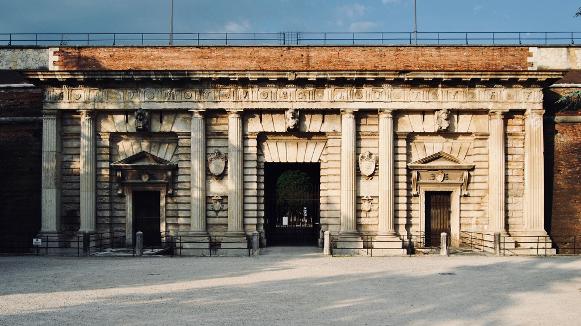
Porta Palio --> Castello Scaligero (Castelvecchio) (10 min)
Continue straight in Stradone Porta Palio for 800 meters and you will see Castelvecchio Castle, Bridge and Museum on your left.

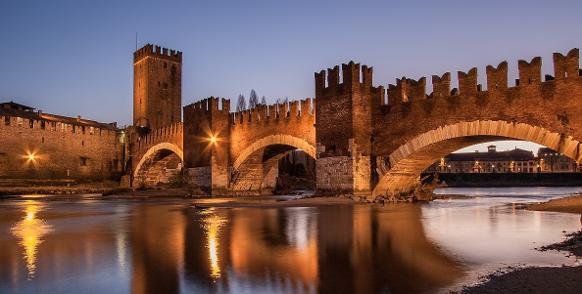
Castello Scaligero (Castelvecchio)
Built by the Della Scala family in the mid 1300s, and one of the most representative monuments of the city. In addition, this ancient building houses one of the most important museums in Verona, also known for its renovation by Carlo Scarpa, one of the most important architects of the twentieth century. In the museum you can admire collections of medieval, renaissance and modern art through various historical and artistic paths. If you are interested in the history of the city and ancient art, you can't miss a visit to this wonderful museum.

Castelvecchio --> Arco dei Gavi (2 min)
Looking at Castelvecchio, Arco dei Gavi is just on its right.
Arco dei Gavi
On the right side of Castelvecchio, in a small green area overlooking the Adige River, stands this first-century AD construction by the Roman architect Lucius Vitruvius Cerdone. The signature of the author on the monument, a very rare phenomenon in the classical age, is one of the aspects that have made the arch famous. It was built to celebrate one of the most important families of Roman Verona, the gens Gavia.
Originally it was located on the via Postumia, not far from the present clock tower of Castelvecchio (the original location is recognizable for the signaling, on the pavement, of the position of the bases of the pillars). In the Middle Ages the arch, between the Scaliger walls and the Tower, was used as a city gate. In the 16th century, some buildings were erected and some stores were established there.

Arco dei Gavi --> Arena (5 min)
In front of Castelvecchio, you take Via Roma and in 400 meters you'll reach Piazza Bra and you'll see Arena on your left.

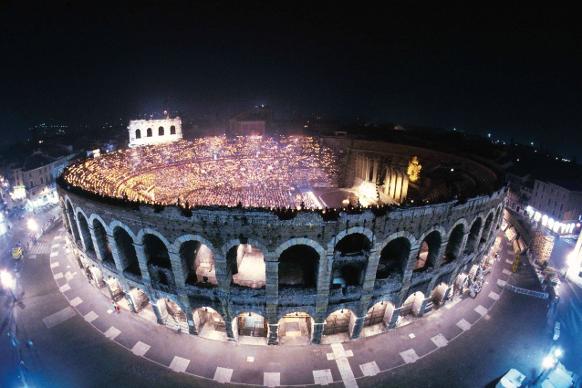
Arena
Arena is the Roman amphitheater in Verona. It was built in the first century A.D. to watch gladiator fights. It is the third largest Roman amphitheater among those still existing and is used in summer for opera, concerts and events. It is the monument that best represents the city.
Verona is often referred to as "little Rome" for the abundance and state of preservation of its artifacts. As such it also has its own "little Colosseum", namely the Arena. Compared to the Flavian Amphitheater in Rome, the Arena of Verona is less than half the size, but in the course of its long life has continued and continues to be used for shows of all kinds, especially musical ones.

Arena --> San Fermo Church (10 min)
Take Via Leoncino, arrive till the end, then turn right and you'll see San Fermo Church.
Refined example of the Gothic style spread in Italy by the Order of Friars Minor, it is a singular case for the references to French architecture, especially in the upper part of the building, with spires and pinnacles unusual in the city scenario. Inside, as in a casket, is kept the lower Benedictine church, jewel of the local Romanesque architecture.
The history of S. Fermo is an extraordinary testimony, over the centuries, of the devotion to the martyred saints Fermo and Rustico, killed in 304 A.D. along the banks of the Adige River. Their story is well told in the bronze bas-reliefs that decorate the portal, the work of 1997 of the master Luciano Minguzzi.
San Fermo Church --> Porta Leoni (2 min)
Come back from when you came, take via Cappello, where at the beginning on your right you'll find Porta Leoni


Porta Leoni
Porta Leoni was the gateway that gave access to the cardo massimo, one of the two main roads of Roman Verona. The name derives from a sarcophagus found nearby on whose cover two lions are carved.
According to an unconfirmed legend, the name derives from a tunnel that led from this access to the Arena and that served the passage of the fairs for the gladiatorial shows. Of the original door remains only the left half of the inner facade, which, however, allows to appreciate the various construction techniques of the Roman doors of Verona. Both Porta Leoni and Porta Borsari were in fact characterized by the same structure. The gate itself was a sort of small fortress with courtyards and inner rooms, built in brick and tuff in the Republican age. To this, during the great work of beautification and rebuilding of the city that took place in the imperial era was added a white limestone facade richly decorated.

Porta Leoni --> Juliet's House (2 min)
Continue straight in Via Cappello, after 200 meters on your right you'll reach Juliet's house.
Juliet's house is a tower house of the late thirteenth and early fourteenth century. On a stone in the wall there is a bas-relief of a hat. Popular tradition considers it the coat of arms of the Cappelletti or Capuleti, Juliet's family. At the beginning of '900 Juliet's house was restored to give it back its ancient medieval appearance and open it to visitors.
In the 1700s Verona became part of the Grand Tour. European nobles and artists who came to the city wanted to visit the places of the legend of Romeo and Juliet. They took them to see the "stal del capel", a building with a courtyard a few steps from the central Piazza Erbe. In the keystone of the entrance arch is carved a hat, perhaps the coat of arms of the family that lived there in the Middle Ages.
Popular tradition said that it was the Capuleti family, or Cappelletti according to the versions of Romeo and Juliet by Luigi da Porto and Matteo Bandello, the first to write about Romeo and Juliet.
Juliet's House --> Piazza delle Erbe (2 min)
Continue on Via Cappello for 200 meters and you'll enter in Piazza delle Erbe, passing Berto Barbarani's monument. Berto will be overlook Torre dei Lamberti on his right.


Piazza Erbe
Piazza delle Erbe is an enchanted corner of Verona. A corner where palaces, towers, statues and architectural elements from various eras have been superimposed creating a harmonious, unique and unrepeatable layered collage. In international guides it is described as one of the most beautiful squares in Italy.
For many centuries Piazza Erbe has been the fulcrum of the social, economic and religious life of Verona. In Roman times it housed the Forum, of which the current square preserves the original length: there were the Capitol, Temples and Baths, connected by an arcade that housed many stores. In the communal period was the seat of political power and with the Scaligeri became a lively center of arts and commerce. During the Venetian domination first and then the Austrian, welcomed the civil and criminal court, but always remained the meeting place and market preferred by the people of Verona.

Piazza delle Erbe --> Torre dei Lamberti (1 min)
From the middle of Piazza Erbe, passing under the rib (la costa), you'll find on the right the entrance to Torre dei Lamberti. Buying a ticket you can access to the top and have a marvellous view of the entire city center and surroundings.
Erected in 1172 by the family of the same name following the Romanesque style typical of that period and still visible today in the lower part, made of bricks alternating with tuff. Over the centuries it has undergone several elevations, in a succession of materials and styles always happily combined, until 1464 when, with the addition of the octagonal belfry, it reached 84 meters and became the highest tower in Verona. From the courtyard behind the Mercato Vecchio (Old Market) you can reach the top of the tower by elevator, enjoying an incomparable view of the city. The adjacent 13th century "Casa dei Giudici" also had various important functions over the centuries: initially used as the residence-office of the Podestà with the name Domus Nova, it became the seat of the city councils and the residence of the judges sent by Venice during the Serenissima.
Torre dei Lamberti --> Piazza dei Signori (1 min)
Exiting from the main entrance of Torre dei Lamberti, on your right you'll be in Piazza dei Signori, or Piazza Dante (so called fromVerona inhabitants)

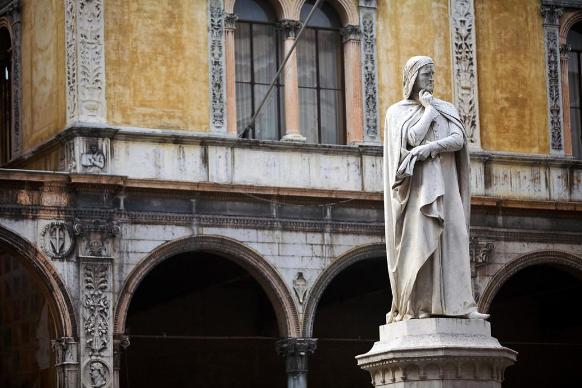
Piazza dei Signori
The difference between piazza Erbe and piazza dei Signori, although located next to each other, is immediate and remarkable: piazza Erbe is as articulated, popular and typically "Italian" as piazza dei Signori is harmonious, aristocratic and intimate. In the Middle Ages it housed the court of the Signoria degli Scaligeri.
From Piazza delle Erbe, which was the central point of political power in Roman and municipal times, you can access Piazza dei Signori, which took over the baton at the time of the Scaliger Seignory and the Serenissima Republic, by crossing the Arco della Costa located between the thirteenth-century Palazzo del Comune and the Domus Nova. You can also get there by passing a narrow lane located in the middle of the Case Mazzanti: volto Barbaro, where a marble plaque commemorates the mortal ambush attempted on October 26, 1277 to Mastino I, founder of the Signoria Scaligera. Arriving from via della Costa we find on our right the thirteenth-century Palazzo della Ragione and the Scaliger Palace of Cansignorio. On the bottom of the square there is the Scaliger palace of Cangrande and on his left the loggia of Fra Giocondo, elegant example of Renaissance architecture; the perimeter is closed by the Palazzo della Pietà and the baroque facade of Domus Nova. At the center of the square stands the monument dedicated to Dante Alighieri, built in 1865 to celebrate the sixth centenary of the birth of the great poet, who during his exile from Florence was a long time guest in Verona. It is a splendid marble statue, three meters high and supported by a pedestal in which Dante, turning his back to Via delle Fogge, has his head slightly turned towards the palace of Cansignorio.

Piazza dei Signori --> Palazzo della Ragione (1 min)
Just next to Torre dei Lamberti entrance you can access to a little square overlooked by Lamberti tower where you'll find Palazzo della Ragione with its beautiful stairway and its museum.
Palazzo della Ragione
The Palazzo della Ragione, now an important museum, was built in the last years of the twelfth century to accommodate the magistrates of the City. It originally had the appearance of those fortified residences that were so widespread in that tumultuous era, defended by four mighty corner towers, of which only the two facing Piazza delle Erbe remain today. A small face on the right leads to the courtyard of the Mercato Vecchio (Old Market), ancient seat of the commercial activities and the city market. Here stands out in all its beauty the marble Scala della Ragione (Stairway of Reason), which led to the inside of the Tribunal. An entrance hidden under it leads to the Lamberti Tower, whose top is accessible by stairs or a convenient elevator.

Palazzo della Ragione --> Arche Scaligere (1 min)
Exiting north-east from Piazza dei Signori, you'll pass under Arco di Tortura and you'll have on your right the marvellous Arche Scaligere.


Arche Scaligere
Near the church of S. Maria Antica, in a square almost an appendix of Piazza dei Signori, you can admire the monumental tombs of the Scaligeri, distinguished monuments of Gothic art.
In a splendid wrought-iron enclosure, with rich decorations on which the motif of the staircase (symbol of the lords) stands out, are enclosed several sarcophagi placed on the ground or on shelves (the first to be buried here seems to have been Mastino I in 1277), but above all the three monumental marble canopied tombs of Cangrande I, Mastino II and Cansignorio.
The three major arches, surmounted by cusps, bearing the equestrian statue of the deceased and surrounded by numerous decorative elements, have worked many artists, especially stone Venetian, Lombard and Tuscan.

Arche Scaligere --> Via Sottoriva (2 min)
Continue straigth on Via Santa Maria in Chiavica, then Vicolo Due Stelle till you'll enter in Via Sottoriva.
Via Sottoriva
It is one of the most characteristic streets of Verona, one of those that still retains the appearance of the old Verona. Because of its low level, in the past it had the sad privilege of always being among the first to be flooded. At its northern end, at the height of Santa Anastasia, it borders with the Brà dei Molinari, which is accessed through a narrow passage between the apse of the church and a small house, now demolished. Brà had the meaning of a large river square, because at that point the Adige had its maximum extension towards the Acqua Morta canal before the walls. There is a splendid view of Castel San Pietro, the Scaliger walls, and the river with its bridges.
Via Sottoriva is today one of the quietest streets in the center.

Via Sottoriva --> Ponte Pietra (5 min)
Walk on Via Sottoriva heading north, keeping Adige River on your right. Keep right on Via Ponte Pietra till you'll reach the historical bridge on your right.


Ponte Pietra
Ponte Pietra (Stone Bridge) is the first construction realized by the Romans when they arrived in Verona in the first century B.C. It is characterized by the combination of two different materials: the original white stone and the bricks that replaced the damages suffered by floods and war. It preserves the characteristic donkey-back shape of Roman bridges.
The Romans arrived in Verona at the beginning of the first century BC. The city was built within a deep bend of the Adige River, which with its current guaranteed a natural defense to two thirds of the settlement. In order not to remain isolated, however, they also built a bridge that allowed them to cross the river. This bridge was built at the northern vertex of the great bend of the Adige where the river bed is formed by a solid rocky base, the banks are close and the water is less deep.

Ponte Pietra --> Teatro Romano (3 min)
From Ponte Pietra, over the Adige River, on your right you'll see Teatro Romano dominated by Castel San Pietro.
Teatro Romano
The theater was built on the slopes of the hill of San Pietro towards the end of the first century B.C., during the principality of Octavian Augustus.
The construction, of spectacular grandeur, extended from the left bank of the Adige to the summit of the hill, and was in a scenic relationship with the Roman urban system, located on the right bank of the river.
Over the centuries civil and religious buildings were erected on the ruins of the theater; in 1834 Andrea Monga, a wealthy merchant from Verona, purchased part of the houses built in the area to carry out excavations, which led to the recovery of significant remains.
The theater responds to the architectural canons of this type of buildings: the cavea reserved for spectators, divided into two sections and vertically in wedges; the semicircular orchestra at the foot of the steps; the scene, reserved for actors. During the summer, theatrical and musical performances are held here (Veronese Summer Theater).

Teatro Romano --> Castel San Pietro (8 min)
To reach Castel San Pietro you can take the 100 steps immediately in front of Ponte Pietra or take the funicular from Via Fontanelle Santo Stefano 6.


The view from the top will repay you for the effort of reaching the square.
On show evenings at the Roman Theatre, which is located just below the square, you can enjoy the notes coming from the stage a few meters below you.
Castel San Pietro
The ancient city as seen from Castel San Pietro.
San Pietro's hill is a suggestive hill that rises for a few hundred meters behind the Roman Theatre.
Its top, in an easily defensible position and close to the water of the Adige, inhabited since the mists of time, houses a nineteenth-century military barracks, built by the Austrians.
It offers wonderful views of the historic center of Verona.

Castel San Pietro --> San Giorgio Church (6 min)
Walk with Adige River on your left till you'll reach San Giorgio Church.
You'll enjoy a great view in front of view but on your back, too.

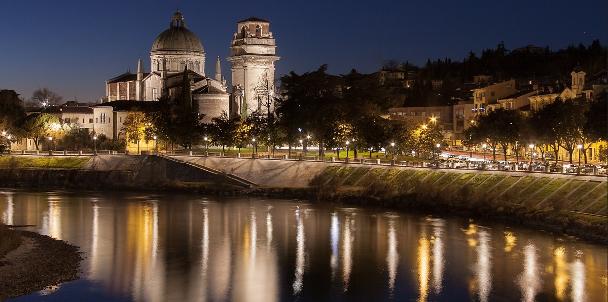
San Giorgio Church
The church of San Giorgio is located in the northern part of the city, not far from the homonymous door with its imposing white stone facade. Built at the end of the fifteenth century, it is flanked by a majestic dome and a bell tower attributed to Michele Sanmicheli, the greatest Veronese architect of the time.
Looking at the white marble façade of the church of San Giorgio in Braida you can see typical elements of Renaissance architecture, such as the presence of the serliana on the upper floor, and others typical of the seventeenth century, such as the volute that divides the two floors. The church, in fact, even though it was begun during the Renaissance, is very much influenced by the counter-reformation climate of the seventeenth century. Note the perfect symmetry between the two floors: the opening of the serliana that is found in the entrance door of the lower floor, the orders of flattened pillars, above Corinthian, below Ionic. In the two niches at the sides of the door there are the statues of San Giustignano and San Giorgio, who is portrayed according to the traditional iconography as a young soldier of good appearance.

San Giorgio Church --> Duomo (Verona's Chatedral) (7 min)
The cathedral of Verona, whose official name is the Cathedral of Santa Maria Assunta but also known as the Cathedral of Santa Maria Matricolare, from the name of the ancient early Christian church, is the main place of Catholic worship in the city of Verona, mother church of the homonymous diocese.
It is part of an articulated architectural complex, which also includes the palace of the Bishopric, the cloister of the Canons, the capitular library, the baptistery of San Giovanni in Fonte and the church of Sant'Elena, the latter two connected to the cathedral through the arcade of Santa Maria Matricolare.
Duomo (Verona Chatedral) --> Santa Anastasia Church (5 min)

The Basilica of St. Anastasia is a masterful example of Italian Gothic.
It preserves the name of a pre-existing church of the Lombard era, dedicated to the virgin Anastasia, martyr of the fourth century.
The building was located at the end of the decumanus maximus: the main Roman road of Verona that connected Porta Borsàri to the disappeared Ponte Postumio.
Around 1290 the Dominicans settled here and began the construction of the Gothic Basilica, dedicated to St. Peter the Martyr, a Dominican native of Verona and the patron saint, along with St. Zeno, of the city.

Sant'Anastasia Church --> Porta Borsari (7 min)
Porta Borsari
Porta Borsari was the gate of "representation" of the Roman city, located on the main access to the city, the one on the Postumia, an important communication route, "highway" of the past that connected Aquileia with Genoa. The name "Borsari" was given in the Middle Ages, when on the door were placed the gabellieri who stored the duties on incoming goods inside large bags. The Roman name was probably Porta Iovia, from a temple dedicated to Jupiter that stood nearby, the remains of which were found during excavations a few years ago. What remains today of the Roman gate is only the decorative white limestone facade. The gate itself, a small fort built of brick and tuff, has been completely destroyed. On the buildings to the left of the door are still visible traces of the Roman wall used as foundations for the construction of seventeenth-century palaces. Porta Borsari, like many Roman buildings in Verona, was an important source of inspiration for Renaissance artists and architects. The not far Palazzo Bevilacqua designed by Michele Sanmicheli, takes up, almost an urban rhyme, the beautiful twisted columns of Porta Borsari.

Porta Borsari --> San Zeno (15 min)

The Basilica of San Zeno is undoubtedly one of the most beautiful Romanesque churches in Italy.
The intense chromatism, given by the use of tuff stone used alone or alternated with bricks, is immediately impressed in the visitor's memory.
The façade, ideally enclosed on the left by the Abbey tower (13th century) and on the right by the elegant bell tower (12th century), is colorfully suggestive, harmonious and perfect in its architectural lines, sober and light in its decoration: it reflects the influence of Lombard-Emilian architecture in Veneto.
San Zeno --> Palladio20 Loft & Terrace (20 min)

Traduce questa pagina
Crea un sito Web gratuito con Yola